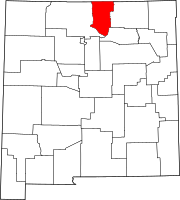

Tres Piedras ( Spanish: three rocks) [1] is an unincorporated community in Taos County, northern New Mexico, United States, adjacent to Carson National Forest.
Geography
Tres Piedras is located approximately 30 miles northwest of Taos, and west of the Rio Grande on U.S. Route 64. At approximately 8,000 feet (2,400 m) in altitude, it is located within the southern portion of the San Juan Range of the Rocky Mountains. Tres Piedras is on the western edge of a sagebrush plain, with ponderosa pines growing throughout the village. [2] The village is adjacent to the Carson National Forest. [3] The ZIP Code for Tres Piedras is 87577. [4]
Climate
| Climate data for Tres Piedras, New Mexico, 1991–2020 normals, 1905-2020 extremes: 8139ft (2481m) | |||||||||||||
|---|---|---|---|---|---|---|---|---|---|---|---|---|---|
| Month | Jan | Feb | Mar | Apr | May | Jun | Jul | Aug | Sep | Oct | Nov | Dec | Year |
| Record high °F (°C) | 61 (16) |
67 (19) |
71 (22) |
80 (27) |
87 (31) |
95 (35) |
93 (34) |
92 (33) |
89 (32) |
89 (32) |
74 (23) |
64 (18) |
95 (35) |
| Mean maximum °F (°C) | 49.7 (9.8) |
52.3 (11.3) |
62.2 (16.8) |
69.1 (20.6) |
79.6 (26.4) |
85.1 (29.5) |
88.3 (31.3) |
84.5 (29.2) |
80.0 (26.7) |
73.2 (22.9) |
61.3 (16.3) |
51.9 (11.1) |
86.6 (30.3) |
| Mean daily maximum °F (°C) | 37.5 (3.1) |
40.8 (4.9) |
50.3 (10.2) |
58.6 (14.8) |
66.1 (18.9) |
79.0 (26.1) |
81.3 (27.4) |
77.9 (25.5) |
72.3 (22.4) |
61.5 (16.4) |
47.7 (8.7) |
38.5 (3.6) |
59.3 (15.2) |
| Daily mean °F (°C) | 22.7 (−5.2) |
26.5 (−3.1) |
34.9 (1.6) |
42.1 (5.6) |
49.6 (9.8) |
60.9 (16.1) |
64.8 (18.2) |
62.7 (17.1) |
56.3 (13.5) |
45.1 (7.3) |
32.7 (0.4) |
24.2 (−4.3) |
43.5 (6.4) |
| Mean daily minimum °F (°C) | 8.0 (−13.3) |
12.2 (−11.0) |
19.6 (−6.9) |
25.6 (−3.6) |
33.2 (0.7) |
42.7 (5.9) |
48.2 (9.0) |
47.4 (8.6) |
40.4 (4.7) |
28.8 (−1.8) |
17.6 (−8.0) |
9.9 (−12.3) |
27.8 (−2.3) |
| Mean minimum °F (°C) | −7.6 (−22.0) |
−4.9 (−20.5) |
1.7 (−16.8) |
13.0 (−10.6) |
23.1 (−4.9) |
31.0 (−0.6) |
40.0 (4.4) |
40.4 (4.7) |
30.9 (−0.6) |
12.7 (−10.7) |
−0.7 (−18.2) |
−6.1 (−21.2) |
−11.2 (−24.0) |
| Record low °F (°C) | −35 (−37) |
−35 (−37) |
−23 (−31) |
−4 (−20) |
11 (−12) |
16 (−9) |
25 (−4) |
27 (−3) |
15 (−9) |
−5 (−21) |
−22 (−30) |
−37 (−38) |
−37 (−38) |
| Average precipitation inches (mm) | 0.92 (23) |
0.70 (18) |
1.05 (27) |
0.70 (18) |
0.97 (25) |
1.23 (31) |
2.20 (56) |
2.99 (76) |
1.24 (31) |
1.16 (29) |
0.85 (22) |
0.82 (21) |
14.83 (377) |
| Average snowfall inches (cm) | 8.8 (22) |
10.1 (26) |
3.4 (8.6) |
1.0 (2.5) |
0.1 (0.25) |
0.0 (0.0) |
0.0 (0.0) |
0.0 (0.0) |
0.0 (0.0) |
0.8 (2.0) |
3.3 (8.4) |
11.4 (29) |
38.9 (98.75) |
| Source 1: NOAA (1981-2010 precipitation & snowfall) [5] [6] | |||||||||||||
| Source 2: XMACIS2 (records & monthly max/mins) [7] | |||||||||||||
History
The earliest maps, from the 1770s, show the name Piedras de los Carneros, or Rocks of the Sheep, possibly denoting a population of Bighorn Sheep. While the mountains and valleys east of the Rio Grande were colonized by Spanish agriculturalists & pastoralists some 200 years earlier, the Taos Plateau and Tusas Mountains were used by the nomadic peoples: Ute, Comanche, Kiowa and Jicarilla Apache, and so weren't utilized by the pobladores or Hispano colonists until well after the Mexican-American War (1846–1848) and subsequent presence of the U. S. Army.
The village, named for three outcroppings of granite, was settled in 1879 and became a small ranching and timber village. [2] Homesteaders, sawmills, small scale dry farming and mining activity slowly augmented the population through the late nineteenth and early twentieth centuries. Some Mormon pioneers from the San Luis valley to the north also made their way to Tres Piedras and established themselves.
By the turn of the twentieth century several villages were established in the area: Hopewell, 20 miles to the west, a gold-mining town; Las Tusas, nine miles west, a largely Hispanic farming community spread along the river valley of the same name, and No Agua (no water), 9 miles north on the railway line. All three of these places are virtually uninhabited today. Between 1880 and 1941 Tres Piedras was a railroad stop on the narrow gauge Chili Line railroad that operated between Antonito, Colorado and Santa Fe, New Mexico. The village still has the old railroad water tower. [3]
Recreation
It is a granite climbing area, one of two west of the Rio Grande in New Mexico. [1]
References
- ^ a b Dennis R. Jackson (January 1, 2006). New Mexico. Globe Pequot Press. p. 52. ISBN 978-0-7627-3132-9.
- ^ a b Laurence Parent (January 11, 2011). Scenic Driving New Mexico, 3rd. Globe Pequot. p. 18. ISBN 978-0-7627-6762-5.
- ^ a b Laurence Parent (January 11, 2011). Scenic Driving New Mexico, 3rd. Globe Pequot. p. 19. ISBN 978-0-7627-6762-5.
- ^ "Tres Piedras ZIP Code". zipdatamaps.com. 2022. Retrieved November 11, 2022.
- ^ "Tres Piedras, New Mexico 1991-2020 Monthly Normals". Retrieved November 15, 2023.
- ^ "Tres Piedras, New Mexico 1981-2010 Monthly Normals". Retrieved November 15, 2023.
- ^ "xmACIS". National Oceanic and Atmospheric Administration. Retrieved November 15, 2023.
Further reading
- Adelaide K. Bullen; Ripley P. Bullen (1942). A Pueblo Cave Site at Tres Piedras, New Mexico.
